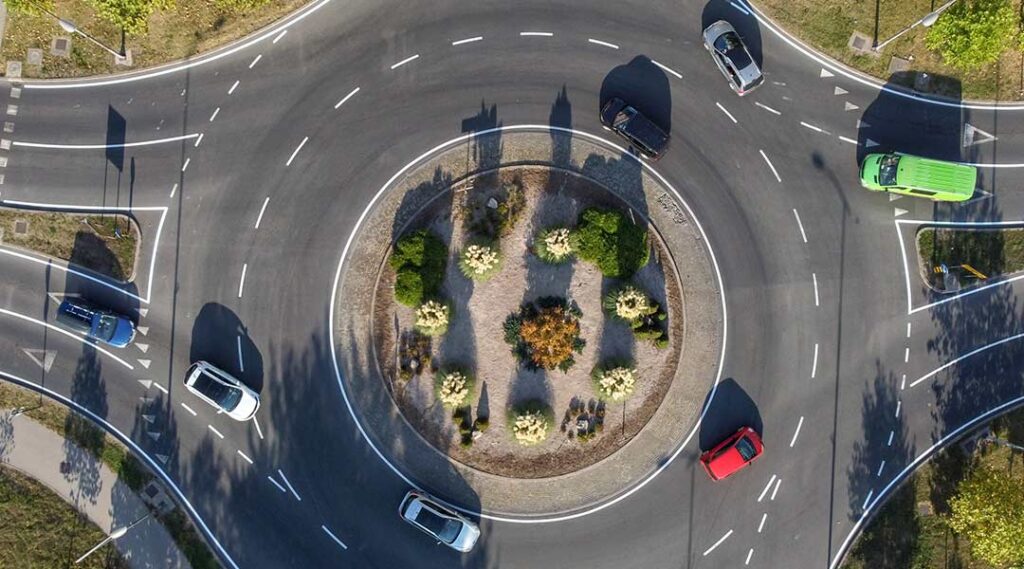This post was originally published on www.progressive.com
Modern roundabouts have been popular in Europe for decades. However, they’ve become more popular in America since the 1990s and have taken some time to catch on. If you’re unfamiliar with how to drive in a roundabout, learning about what they are, why municipalities use roundabouts, and the appropriate driving etiquette for roundabouts can make navigating roundabouts easier.
What’s the difference between roundabouts vs. traffic circles?
There’s some confusion about the difference between roundabouts and traffic circles. Many people use the two terms interchangeably, but they aren’t the same thing. Traffic circle rules differ from roundabout rules, including how traffic circles handle right of way. According to the Rhode Island Department of Transportation, a modern roundabout is a circular intersection that manages multiple roads without the need for a traffic light. The Federal Highway Administration distinguishes the “modern roundabout” from the older, “nonconforming traffic circles.” They improve traffic flow efficiency and make the intersection safer by making it difficult for drivers to get involved in a head-on or T-bone collision, the most dangerous kinds of car accidents.
According to the Washington State Department of Transportation, roundabouts reduce collisions by 37% overall and reduce fatal collisions by 90% compared to traditional intersections. If you get into a collision, carrying adequate auto insurance can help protect you from financial loss.
A traffic circle is a larger style of intersection. A traffic circle is a circular road that joins other roads at right angles. It gives the right of way to those entering the circle (rather than existing traffic), often necessitating traffic lights to control entry and exit. Therefore, due to traffic circle rules, they are prone to traffic jams and can be less efficient than a modern roundabout. Roadway designers used traffic circles for aesthetic reasons rather than to improve safety or traffic flow.
Navigating roundabouts
Driving etiquette for roundabouts includes a few principles you should know to navigate a roundabout successfully.
Know that the roundabout is coming up
Signs will alert you to the upcoming roundabout and show you which lane you should be in, depending on whether you want to turn right, straight, or turn left. You’ll see a triangular traffic island just before the roundabout that serves to slow traffic entering the roundabout. This structure also provides a safe place for pedestrians to wait so that they only cross one direction of traffic at a time.
Yield to traffic/pedestrian crossing in the roundabout
The existing traffic has the right of way in a roundabout, so you’ll need to wait for an opening. You will also need to yield to those trying to cross the road. Pedestrians in a crosswalk have the right of way.
Go counter-clockwise
If you are wondering what direction do you drive in a roundabout, you should always drive counter-clockwise in a roundabout in America. The roundabout is an intersection that follows other basic traffic procedures, so we still drive on the right.
Don’t change lanes in the roundabout
The signs that precede the roundabout guide what lane you should be in based on where you want to go. Once you’re in the roundabout, stay in your lane and wait for your exit. There should be no need to change lanes.
Signal your exit
When you’re getting ready to leave the roundabout, use your right turn signal to alert other drivers that you’re exiting. Signaling your intent to exit the roundabout helps prevent confusion and avoids the possibility of another vehicle entering your exit path.
Don’t panic if you miss your exit
If you miss your exit on a roundabout, keep going in your lane. Take another complete circle and leave the roundabout the next time you reach your desired exit.
Give trucks and other large vehicles space
Because the roundabout is a continuous turn, it can be more difficult for larger vehicles like semis and buses to manage. Give them enough room, and don’t drive right next to them.
Stay off the center circle
There’s no need for you to drive on the raised circle in the roundabout’s center. It’s there as a buffer to allow large vehicles more space to turn, not as a passing lane for cars.
[ad_1]
